SATURDAY
JUNE 15 - 2019
Friends
of Wildlife Group
I was very pleased to meet up again with several
friends from the old Havant Wildlife Group to lead
this morning's walk on Brook Meadow. Nine of us
assembled in Bridge Road car park where I invited them
to look at a rare plant called Sulphur
Cinquefoil (Potentilla recta) which was in flower
on the wayside.
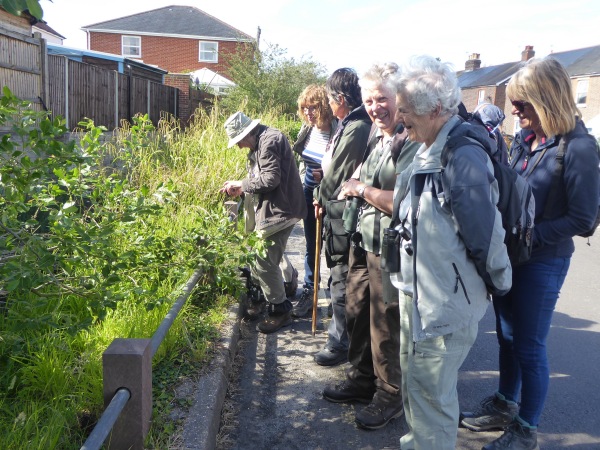
Unlike the more common
Creeping Cinquefoil, Sulphur Cinquefoil is an erect
plant with a cluster of flowers at the top of the
stem. It is a regular plant on this wayside where I
have recorded it most years since 2011. It is
described as 'Rare' in my old copy of 'The Flora of
Hampshire' (1996), though I am not sure what its
present status. It was introduced into Britain by
1648, and was known from the wild by 1858 (Middlesex),
so it is fairly well established though still rare in
this area.
We made our way to
Brook Meadow via the Seagull Lane entrance. First we
looked at the English Oaks which the group has planted
on this site, including those which I and my wife
planted in Jubilee year 2012. All the trees have been
carefully maintained by the conservation group and are
in excellent health. Here is a photo the group took of
me now dwarfed by the tree I planted.
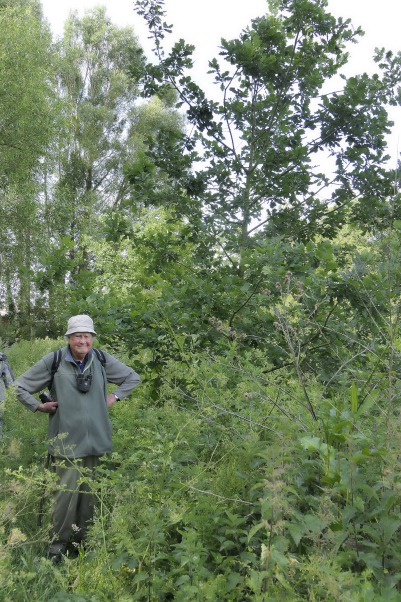
I also pointed out the
American Red Oak planted in memory of our
erstwhile colleague Tony Wilkinson. Derek got this
image of acorns just starting to develop.

We went over the north
bridge and along the north path by the railway line
where I pointed out a hole in a Crack Willow which
houses a nest of Tree Bumblebees (Bombus
hypnorum). It is a ginger species with a
distinctive darkened abdomen and a white tail. We saw
a number of bees coming to and from the nest while we
were present. This Bumblebee is a newcomer to Britain
having colonised our country in 2001. It is a very
welcome arrival!
We walked down the
east side of the north meadow admiring the wonderful
array of grasses, swaying in the breeze. We noted in
particular the delicate panicles of False Oat-grass
(with awns on its spikelets) and the beautiful reddish
anthers of Cocksfoot.
When examining the
grasses, we paid homage to the memory of our erstwhile
colleague and excellent botanist Gwynne
Johnson. We also admired the developing fruits on
the Rowan plantation that was planted in Gwynne's
memory in 2005. Like the Oaks, these trees are being
carefully tended to by the conservation group.
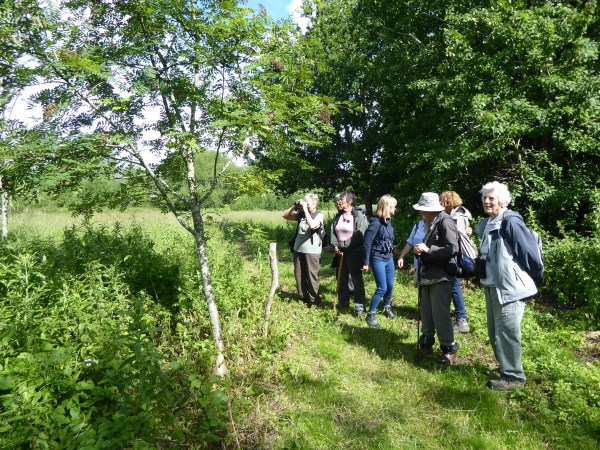
Here is a link to a
tribute page to Gwynne . . . Gwynne
Johnson
We stopped by Beryl's
seat to examine the rare Hybrid Fescue (x
Festulolium loliaceum) which has characteristics
of its two nearby parent grasses, namely Perennial
Ryegrass and Meadow Fescue, ie Ryegrass arrangement of
Fescue-like spikelets
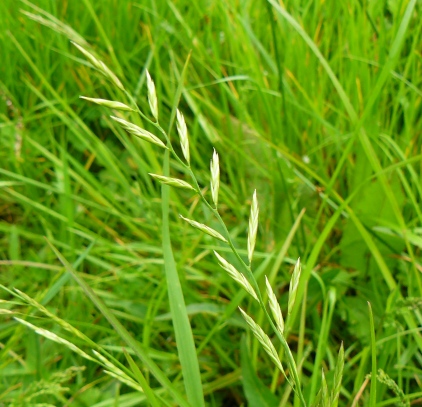
I asked the group to
follow me closely onto the main orchid area and to be
extra careful not to tread on any small
orchids.

Everyone was delighted
to see the multitude of Southern Marsh and Common
Spotted Orchids along with a scattering of the smaller
more delicate Bee Orchids and the single Pyramidal
Orchid.
The attractive
(orchid-like) flower spikes of Hedge Woundwort
were seen in various places around the meadow.
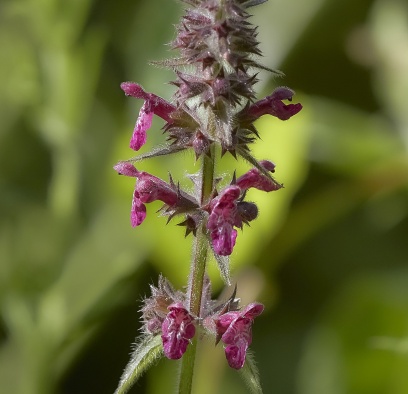
We had our coffee
break at the main seat and Derek kindly took a photo
of us all including me!

From the seat we saw a
pair of Whitethroats coming and going, collecting
grubs for nestlings. Heather got a delightful shot of
a young Whitethroat which is our first indication of
successful Whitethroat breeding this year. Brilliant.
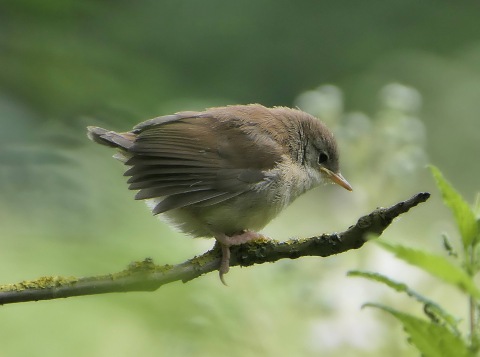
After the break I took
the group on an adventure walking through the tall
grasses on the centre meadow, where we came across two
patches of star-like Lesser Stitchwort and several
clumps of white and purple flowered Common Comfrey. We
stopped to admire the very tall spikes of Reed
Canary-grass which is the tallest grass on Brook
Meadow.
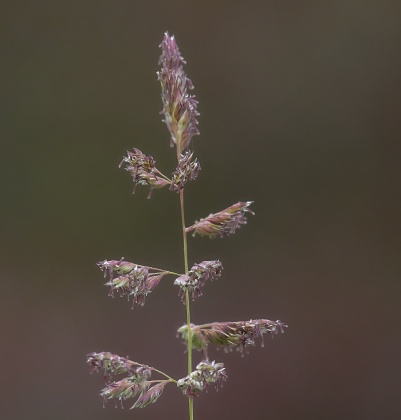
On the bird front we
were entertained in song by several Blackcaps and Song
Thrushes, the later belting out their repetitive songs
across the meadow. Chiffchaff and Whitethroat were
also heard along with Blackbird and Wren. Heather
spotted a single Swift flying over the meadow, the
first I have seen this year. Swifts are such rare
birds in this area, where they used to be fairly
common.
Regarding butterflies
we were delighted to get a good view of a Small
Tortoiseshell resting in the vegetation. We also
saw one Common Blue, a Red Admiral and several Meadow
Browns. A Cinnabar moth was spotted appropriately
close to some Hoary Ragwort plants. A Crab
Spider was caught on a Southern Marsh Orchid
Walking back along the
main river path we saw good numbers of Ladybird larvae
in various stages of development resting on nettle
leaves. It has been a good year for Ladybirds.
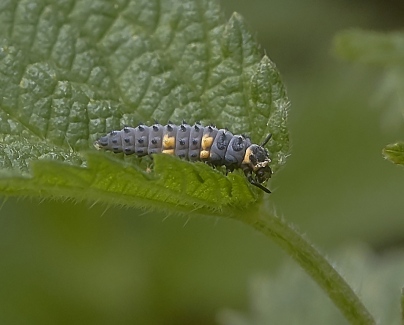
On the Lumley area I
picked a few sedges for the group to get a good look
at these underrated plants, including Distant Sedge
(Carex distans) and the nationally scarce Divided
Sedge (Carex divisa). We also stopped to admire yet
more orchids including one Bee Orchid with 8 flowers!

Along the small wet
path down to the Lumley Stream (where I had my last
Water Vole sighting over 2 years ago) we saw a number
of interesting plants which Ros applied her botanical
ID skills to: Celery-leaved Buttercup, Blue
Water-speedwell and Brooklime.
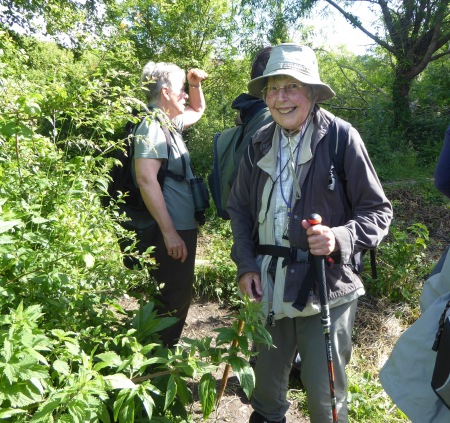
Thanks to everyone for
contributing to such an enjoyable experience.
For more information
about this local wildlife group go to . . .
Havant
Wildlife Group
FRIDAY
JUNE 14 - 2019
Brook
Meadow signcases
Dan Mortimer
came round to my place at 10am to collect the three
display boards for installing in the signcases. This
system is working well, with Dan bringing the boards
to me at my house for me to prepare the displays at my
leisure and then collecting them when I had finished
for installation in the three signcases. I would not
be able to manage this on my own. I chose this morning
as the forecast was fairly good, but inevitably it
started to rain as we were installing the boards. But
all went well. This is my summer update. The next one
will be autumn in September.
Dan struggling to
put the screws in the signcase

Other
observations
While I was on
the meadow I noticed the first flowering of
Creeping Thistle along the main river path -
exactly the same date as the first flowers last year.
They must have a built in calendar!

Also in flower was a
mass of Water-cress on the river bank south of
the north bridge.
I was surprised to hear three Song Thrushes
singing strongly. I usually hear one or two at the
most, but to get three blasting out their repetitive
songs was quite something!
I think the group will need to tackle the Hemlock
Water-dropwort on the Lumley area. It is slowly
but relentlessly encroaching onto this valuable wild
flower area. It is no good just cutting them down they
need to be dug out which is a hard but very worthwhile
job.
Japanese Honeysuckle (Lonicera japonica) is
flowering near the Lumley gate. This alien plant has
red rather than black berries which the native
Honeysuckle has.
A branch of the large
Crack Willow at the end of the north path has
fallen across the river and onto the railway
embankment. It is partially resting on the bridge over
the culvert which takes the River Ems under the
railway line. The river is still flowing OK and no
damage appears to have been done on the railway side.

More
Bee Orchids
I went over to
the meadow again this afternoon mainly to have a look
at the orchids with a view to the walk I shall be
leading tomorrow morning for the Friends of Wildlife
Group. Despite the heavy rain over the past couple of
days the orchids are still showing very well though
the surrounding vegetation will soon envelope them.
While going round the
main orchid area on the north meadow I came across 6
Bee Orchids which we have not seen before on that area
this year. These orchids are not very large and seem
to have flowers yet to open. Encouraged by this
discovery I had another search around the Lumley area
where I counted 19 Bee Orchids, and there could have
been more, bringing the overall total to 25 Bee
Orchids. This is the second best count of Bee
Orchids, falling just short of the 29 spikes counted
in 2015.

While on the orchid
area I also found a Pyramidal Orchid in much
the same place as last year. There is just one, but
others may yet appear as Pyramidal Orchid is a
relatively late flowering orchid. Common
Knapweed is also just starting to open its flowers
on the Lumley area.
Sulphur
Cinquefoil on Bridge Road
I was
interested to see what I think is Sulphur Cinquefoil
(Potentilla recta) in flower on the
southern area of the wayside. This is a regular plant
on this wayside where I have recorded it most years
since 2011. It is always in the same spot so most
likely perennial. It is described as 'Rare' in my old
copy of 'The Flora of Hampshire' (1996), though I am
not sure what its present status. It is described as
'scarce' in The Flora of Sussex and that it seldom
persists for more than a few years. It was introduced
into Britain by 1648, and was known from the wild by
1858 (Middlesex).
Sorry about the
photos, but my camera does not like yellow
flowers!
TUESDAY
JUNE 11 - 2019
North
Common, Northney
I spent an
enjoyable couple of hours this morning wandering
around the North Common Nature Reserve at Northney. I
know it quite well, though Ihave not been there for
some years, so it was good to get reacquainted. It is
such a peaceful spot with fine views across the
channel to Warblington. I have lots of memories of
walks with the Havant Wildlife Group with Gwynne and
Nigel Johnson searching for tiny plants on their
knees.
I walked along the main path the surface of which has
been improved to wheelchair standard. I stopped to
have a look at a rather fine interpretation board made
by the Chichester Harbour Conservancy.

I noted Dove's-foot
Cranesbill with its distinctive leaves and Creeping
Thistle with buds about to burst into flower. Bristly
Ox-tongue is now in full flower.
There were several
Meadow Browns flying around including this dark
specimen that paused for a photo. Also, what was my
first Marbled White butterfly of the year fluttered
past without stopping, so no photo.

At the end of the main
path is a large open area in front of the new houses
where the orchids grow.

I saw many Bee Orchids
(20+) and a few Pyramidal Orchids.
Russian Comfrey
was also present - without 'wings' connecting the
leaves and stems. It is a more 'delicate' plant than
Common Comfrey. This is the only place I know to see
Russian Comfrey, I have looked hard for it on Brook
Meadow, but without success.

I also managed to
locate a few examples of Grass Vetchling which
this site is renowned for. The flowers were too small
for my simple camera to get into focus, so here is one
I took some years ago. One has to be careful to
distinguish Grass Vetchling from the similar flowered
Common Vetch though the leaves are quite
different.
The biggest surprise
was to see so much Salsify, in flower and some
with huge seedheads. I did not count them but there
must have been well over 100. I do not recall having
seen these attractive plants here before.
I gather Salsify used
to be grown as a vegetable and its presence in the
wild usually indicates a garden outcast or relic. It
is a similar plant to the native Goat's-beard though
the flowers are large and coloured purple. Apparently,
these plants can hybridise producing flowers with a
mixture of yellow Goat's-beard and purple Salsify. I
did not see any indication of that today.
Other plants in this
interesting open area included Corky-fruited
Water-dropwort Hop Trfefoil and Perforate St
John's-wort.
There was also a small yellow flower with prominent
green sepals which I could not identify. It looked a
bit like Yellow-wort but that does not fit. Can anyone
help? It might be a Potentilla bud (e.g. Creeping
Cinquefoil) pushing through other leaves. However,
this seems unlikely as it was not an isolated case. I
saw many others much the same.

Emsworth-Warblington-Langstone
Peter
Milinets-Raby had a big wander this morning, taking in
Emsworth, Warblington and Langstone Mill Pond (9:15am
to 12:15pm - tide dropping).
Beacon Square: So near, yet so far away . . . A Cuckoo
was calling intermittently this morning, the west
breeze helping the call to reach my ears. Alas, the
bird was on Thorney Island, but at least it was good
to hear one! 2 Cormorant. 3 Shelduck
Nore Barn: 1 Little Egret. 2 Mute Swan.
Emsworth Harbour: 1 Common Tern. 4 Mute Swan. 1 Little
Egret.
Warblington cemetery - 9:44am for an hour. Green
Woodpecker feeding young at a nest hole (see photos)
Goldcrest heard singing. 4 Canada Geese flew over
honking heading east. 1 Kestrel. Whitethroat heard
singing.
Off Pook Lane: 1 Great
Crested Grebe (2 yesterday). 6 Shelduck. 1 Common
Tern. 4 Swallow. 4 Little Egrets feeding in the low
tide trickle, along with 4 juvenile Grey Herons.
Langstone Mill Pond:
19+ Little Egrets - mostly squabbling youngsters. They
will all be departing in a couple of weeks, unless
some pairs have a second brood. Nest one of the Grey
Herons appears to be the only occupied nest - feeding
tiny young of second brood. 2 Reed Warblers. Male
Tufted Duck
SUNDAY
JUNE 9 - 2019
Brook
Meadow
I went over to
the meadow this warm and sunny morning mainly to do my
final orchid count of the year. The orchids are still
showing well, but are becoming progressively covered
by long grasses. There was no significant change from
my last count. Here are the final counts:
Southern Marsh Orchid - 114 (103 on the main
orchid area, 10 on the Lumley area and 1 on the centre
meadow).
Common Spotted Orchid - 28 (24 on main orchid
area. 4 on Lumley area).
Bee Orchid - 13 (all on the Lumley
area)
The charts show
Southern Marsh and Common Spotted Orchids with
relatively modest changes from last year, but overall
the numbers continue to increase. Bee Orchids
fluctuate as usual.
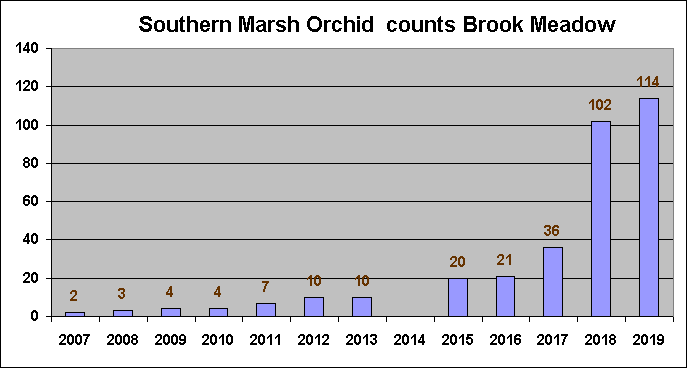
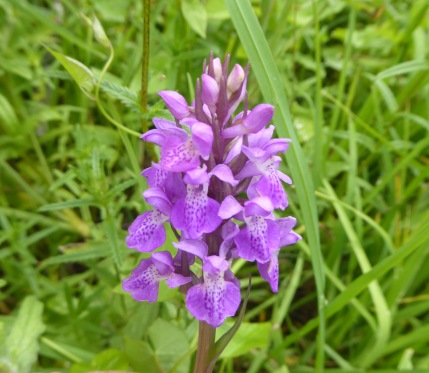
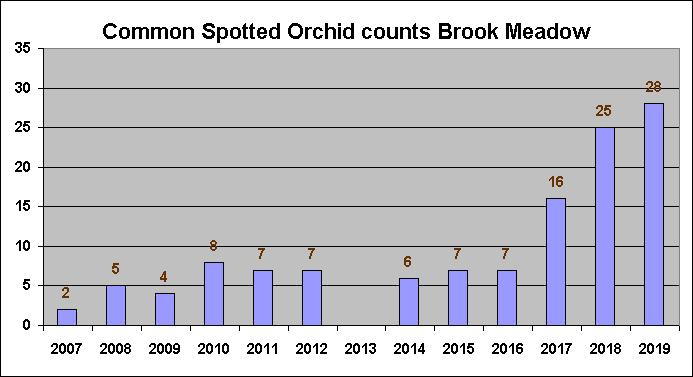


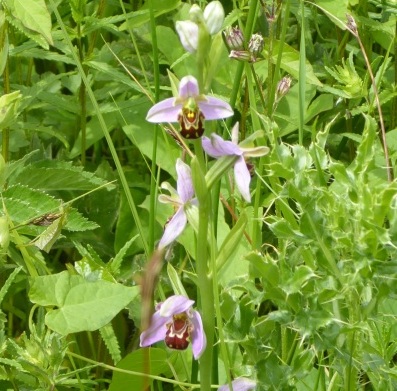
Other
observations
While on the
orchid area I discovered the first red flower buds of
Great Burnet (Sanguisorba officinalis) on the
southern section of the area. Last year we had a crop
of about 20 flowering plants.

I had my first
Hedge Woundwort of the year on the path round
the Lumley area. This is an attractive plant, it has a
rather musty smell. I look forward to finding the less
common but even more attractive Marsh Woundwort later
into the summer.

The casual path down
to the Lumley Stream from the Lumley area is always
interesting botanically. Today, I found some Blue
Water-speedwell (Veronica anagallis-aquatica) in
flower in addition to Brooklime and Celery-leaved
Buttercup which I have noted on previous visits.

This is a wonderful
time of the year for grasses which are abundant on
Brook Meadow. Here is a view of some Tall Fescue and
False Oat-grass.

I looked in the area
around Beryl's seat on the east side of the north
meadow where I found, as expected, a good growth of
the grasses Meadow Fescue and Perennial Ryegrass and
the Hybrid Fescue (x Festulolium
loliaceum). This unusual grass has fescue-like
spikelets arranged in a ryegrass manner on the
stems.
Message
to the conservation group - Please don't cut the
grass around Beryl's seat and along the
path.

I was particularly
pleased to find a small patch of what I am fairly sure
is Spiked Sedge (Carex spicata) on the
Lumley area close to the self-seeded Alder sapling. I
don't always manage to find any of this uncommon sedge
on the meadow. It is very similar to the more common
False Fox Sedge (Carex otrubae) but is
generally smaller and with thinner and less angled
stems. Here is the Spiked Sedge taken this morning.
Interestingly, I also found some Bee Orchids in this
area.

The first true sign
that summer is definitely here was the appearance of
the first Meadow Brown and Common Blue
butterflies on the meadow this morning. Not my best
ever photo of the Meadow Brown, but it will do for the
time being. There will be lots more opportunities.
Gatekeepers, Skippers and possibly Ringlets will be
the next butterflies on the wing.
This was a good
morning for insects. Those I stopped to view included
several Swollen-thighed Beetles (Oedemera
nobilis) on the leaves of vegetation. They are
mostly green coloured, but here is a rather nice
bronze coloured one I captured on camera.

There were several
spiders carrying creamy white egg cocoons which I
think are Wolf Spiders (Pardosa) but species
unknown. Help appreciated. Here are two I
photographed.
SATURDAY
JUNE 8 - 2019
Langstone
Mill Pond
Peter
Milinets-Raby was out down Langstone Mill Pond this
morning from 7:35am to 8:45am. The highlight was a
single summer plumaged Dunlin on the low tide channel.
The only other birds present were 2 Common Tern, a
single Oystercatcher and a single Shelduck (he had 5
on Wednesday).
The pond was quiet with only a pair of Tufted Ducks
present and a couple of singing Reed Warblers, plus
those cute Mallard ducklings doing a D Day re
enactment - see photo .

In the windy
conditions the Little Egret colony was quiet.
The Grey Herons in nest one on the top of the main
Holm Oak have a second brood, but I could not see them
to count, but both adults were present on the nest
regurgitating fish. With all the foliage growing up so
quickly the other heron nests are virtually impossible
to see.
FRIDAY
JUNE 7 - 2019
Brook
Meadow at Pallant
Yesterday, I
took part in a special art day at the Pallant Gallery
in which all gallery volunteers were invited to submit
a work of art for display for one day only. Frankly, I
am no artist, I cannot draw or paint or anything like
that, so for my contribution I decided to create a
photo montage of work, activities and wildlife on
Brook Meadow. The event went very well and my montage
picture was politely received by gallery staff and
other volunteers, though it did seem a bit out of
place among many real works of art. But this is a
first for Brook Meadow to appear in the Pallant
Gallery.

It was really good to
see Jennifer Rye and Lesley Harris at the exhibition
particularly as they were both featured in the
montage.
I think they liked it though they were a bit biased!

Jennifer was pleased
to meet up with Alex whom she knew as a teacher in
Emsworth
Alex now works for the Pallant Gallery as a community
education officer

The event took place
in Room 11 in the gallery
with works of art on the walls by famous artists

The show was organised
by Leo seen here serving refreshments

Leo prides himself on
his cakes and biscuits!

Here is a volunteer's
display with two Ivon Hitchens paintings on the wall
behind. You can see what the opposition was like!
Incidentally, Hitchens will be the next exhibition at
the gallery. I'm looking forward to that!

Leo and curator Louise
discussing the displays. Nice one on the easel behind
Louise!

But this was my
favourite volunteer painting. A lovely watercolour
with grasses, plants, hills, birds, etc.
It was inspired by the Edward Thomas poem
'Adlestrop'.
Who is the artist I wonder?

Brook
Meadow
This morning I
was back on the real Brook Meadow, very wet, in
between heavy showers. Birds singing were Song Thrush,
Wren, Blackbird and Woodpigeon. There were several
Ladybird larvae resting on nettle leaves along
the main path. Here is a larva of a native 7-Spot
Ladybird - a nice change from those alien Harlequins.

Bittersweet
(aka Woody Nightshade) was in flower on the west
bank of the river in front of the steel railings, its
purple petals contrasting well with cones of yellow
stamens.

The berries when they
come are bright red. Newly flowering grasses included
Soft Brome, Perennial Ryegrass and Wall Barley.
WEDNESDAY
JUNE 5 - 2019
Marlpit
Lane
This afternoon
at about 1.30 I went to Marlpit Lane really to listen
for Turtle Dove which has been heard by Dave Cuell and
others along the public footpath to the east of the
lane. I spent about an hour in total walking around
the area and up and down the lane without any sound of
a Turtle Dove. I also listened out for Nightingale,
two of which have been heard singing along the lane
this year, but without luck. Admittedly, it is getting
a bit late for Nightingale song; they only sing for a
short period after arrival in early April. I did hear
Blackcap, Whitethroat and a super Song Thrush trying
its best to render a Nightingale song!
Despite the lack of
Turtle Dove I enjoyed my walk along the footpath where
I saw several bright red Cinnabar moths in
flight and their rugby shirted caterpillars on
the developing Ragwort.
Among the plants on
the path there were lots of Viper's-bugloss and
Weld.
I also came across a
small cluster of what I believe are Common
Broomrapes at the top end of the footpath where it
bends towards the weedy area with black plastic
fencing. Common Broomrape is much smaller than
Knapweed Broomrape that I am familiar with on
Portsdown Hill. It is parasitic on a variety of
plants, especially the pea and daisy families.

I had a walk over the
weedy area where there is a variety of wild flowers
such as Crosswort and Scented Mayweed
and also not so wild flowers such as
Love-in-a-Mist and Opium Poppy.
In addition one could
not miss several huge pale Milk Thistles (not
yet in flower). We used to have some of these near the
Wellness Clinic at Westbourne, but they have gone.

Wild
Clary
On the way
home I stopped off to check on the Wild Clary (Salvia
verbenaca) that has been growing on the council mown
grass verge at the northern end of Christopher Way for
several years. It was good to see these rare plants
still doing well despite of (or maybe because of)
regular Council mowing. I counted about 20 plants most
of which were just starting to flower.
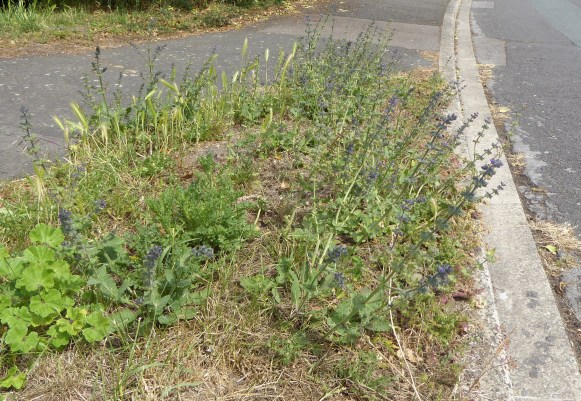

I first discovered
these plants when surveying the local roadside verges
prior to setting up the Friends of Emsworth Waysides
Group in 2011. Their identification was confirmed by
BSBI Hants Recorder Martin Rand Martin who said it was
a first record for the 10km square SU70. Martin
thought it was unlikely to be a garden escape. It was
more likely to be a native and maybe either a survival
of earlier times or an arrival under its own steam.
MONDAY
JUNE 3 - 2019
Riparian
identification course
Today, along
with about 20 other people, I attended a one-day
riparian plant identification course organised by
Sarah Hughes, the Community Wildlife Officer for
Chichester District Council. The course was led by
ecologist, Bruce Middleton and covered the
identification of common waterside plants among many
others.
We started at Tuppenny Barn at 10am for a talk by
Bruce followed by a survey of some of the plants in
the pond on the site. We then went over to Brook
Meadow for lunch followed by a walk around the meadow
with commentary from Bruce finishing at 3pm. The
weather was fine and warm and the day was a great
success. I was pleased to be helpful in providing
specialised local knowledge of Brook Meadow,
particularly regarding orchids and sedges. Here are a
few of my memories of the day with photos.
At the Tuppenny Barn
pond Bruce pointed out a fine tall plant of Greater
Spearwort with a yellow buttercup flower. I am
familiar with the more common Lesser Spearwort, but
not the Greater.

As Bruce was talking I
noticed a large insect fly rapidly over the pond. I
thought at first it was a dragonfly, but when it came
to rest on the surrounding vegetation I realised it
was a magnificent Hornet.

On
Brook Meadow with the study group
In the
afternoon we all went onto Brook Meadow where I guided
the group to a nice shaded area by Beryl's seat for
lunch. Most of the group sat on the ground. It was
very pleasant with birds singing and the grasses
swaying in the breeze.

Bruce is holding up an
Aspen leaf from a tree on the east side of the
north meadow behind the Rowan plantation. The reason
why the leaves of Aspen rustle in the slightest breeze
is due to the flattening of the leaf stems making them
very flexible.

Bruce pointed out the
leaves of a Hop plant just to the right of the
tall Aspen tree which is a new addition to the meadow
plant list. An escape from a nearby garden, maybe?
One of the attendees
who was an entomologist pointed out a large Tree
Bumblebee nest (Bombus hypnorum) in a hole in the
last Crack Willow along the north path going towards
the north-east corner. She thought it could have over
100 bees in it, but unlike Wasps they pose no threat
to people provided they are left alone.

Bruce pointed out the
heart-shaped petals of the flowers on the Dog
Rose on the north path.

We saw two male
Demoiselles chasing one another at the north bend.
I did not see their wings so not sure if they were
Banded Demoiselles or Beautiful Demoiselles. We get
both species on Brook Meadow.
Another new plant for
our year list was Raspberry the leaves of which
were seen by Bruce in the brambles just south of the
western plantation. The leaves are downy white
underneath - not shown in this photo.

We stopped briefly at
the north bridge where
Bruce gave Dan some advice about planting Common Reed
rhizomes.

Bruce spotted Water
Figwort in flower on the river bank opposite the
Bulrushes.
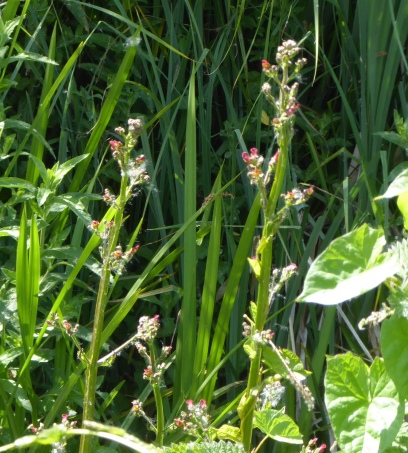
Finally, with half an
hour left, I was delighted to take the group around
the Lumley area where Bruce was most impressed by the
range and abundance of our sedges. Here he is
examining a sample of False Fox Sedge.

Finally here is a shot
of the group admiring the Bee Orchids, which were
easily seen from the path.

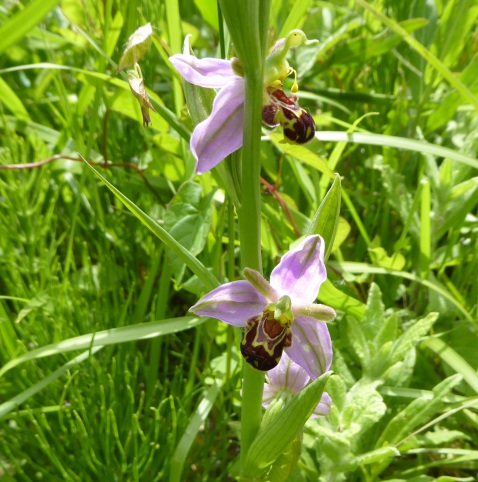
Langstone
Mill Pond
Peter
Milinets-Raby visited Langstone Mill Pond this morning
from 8:54am to 10:15am - tide slowly pushing in.
His report follows . . .
Nothing much on the
tidal mud flats, except 12 adult Herring Gulls
feeding. Obviously the nearby industrial rooftop
nesting birds have young now. I could not find
anything else, not even an Oystercatcher.
The pond was quiet, the female Mallard with four
ducklings are growing fast and getting very
independent. Reed Warblers (5+) seemed to be
everywhere flitting from reed bed to reed bed. Also on
the waters of the pond were 2 male Tufted Duck and a
male Gadwall - all hopefully waiting for ducklings to
hatch??
The Little Egret
colony was in full swing this morning. It is a
shame that the egrets did not breed on the island, as
the views are really rather distant and you need a
scope to appreciate what is going on. The vegetation
has grown up quite quickly in the last week and not
all the nests are as clear as the were a couple of
weeks ago. I counted 41+ adults moving about with 6+
active nests viewable. One pair of squabbling siblings
was unusual as one of the birds had a yellow bill.
This will undoubtedly "grow out" as the bird gets
older or failing that it will cause a stir in October
when it will get misidentified as a Snowy
Egret!

1 Med Gull and 1
Swallow over
SUNDAY
JUNE 2 - 2019
Brook
Meadow Workday
I went over to
the meadow by 9.30am this morning for the regular
first Sunday in the month work session. Weather was
fine and warm. Twelve volunteers attended. The photo
does not show Nigel who had already made a start
widening the paths with the power scythe and Susan
Kelly who arrived late. It was Susan's first time
volunteering on the meadow. Vince was another welcome
newcomer, third from the left on the group photo.

The leader for the
day, Maurice Lillie, outlined the tasks which mainly
involved clearing nettles and other vegetation from
the paths and from young trees and clearing up the
cuttings from the mowing.

It was good to see
Jennifer Rye on the meadow; she has not been able to
attend recent work sessions due to illness.

For the full report
and more photos go to . . . https://www.brookmeadow.org.uk/conservation-news/
Wildlife
observations
I noticed
several Ladybird larvae on nettle leaves along
the main river path. I think this one is the larva of
a Harlequin Ladybird and appears to be preying on a
small mite. Or is it the other way round?

I spotted several
shield bugs on the nettle leaves including these two
Dock Leaf Bugs mating. An attractive
Marmalade Hoverfly (Episyrphus balteatus)
rested on a leaf for a photo. It is fairly common on
Brook Meadow in summer.
Just after our coffee
break, Pauline Bond arrived with a request to see the
Brook Meadow orchids. I jumped at the chance, for I
just love showing people our beautiful orchids. After
looking at and admiring the Southern Marsh and the
Common Spotted Orchids on the main orchid area, we
went down to the Lumley area to have a look at the Bee
Orchids.

While we were walking
on the path round the Lumley area, I happened to spot
a tuft of the grass Crested Dog's-tail growing
right on the path where people walk. Wow! That was a
good find. Things got even better, for as we continued
to walk along the path we found another three tufts of
this attractive grass. I picked a piece to show to the
rest of the conservation group asking them to take
special care when working in that area and certainly
not to cut the path.
Crested Dog's-tail is a rare grass on Brook Meadow and
has not been recorded since 2016 and only occasionally
before that date. Thank you Pauline; if it was not for
you asking to see the Bee Orchids I might well have
missed this grass.
Many other grasses are
now flowering and creating a fine spectacle including
False Oat-grass and Cocksfoot which has red
tinged anthers as shown in this photo.

Montage
art
If you are in
Chichester next Thursday afternoon (6th June, 12.30 to
8.00pm) you might be interested to pop into the
Pallant House Gallery where Brook Meadow will be on
display for the first time ever! To explain. All
gallery volunteers have been invited to present a
piece of their own art work for display in the gallery
on one day only. As I have no artistic talent, I have
decided to present a photo montage of Brook Meadow as
my contribution. I did suggest at first taking a
display of wild flowers and grasses, but gallery rules
would not allow that. So, photos were the next best
thing. Here is a preview of what the montage looks
like, but I am still working on it.

SATURDAY
JUNE 1 - 2019
Hedgehogs
The trail
camera picked up the regular two Hedgehogs in the
garden last night. They were present on and off from
about 10pm until 4am. As usual I scattered a few
mealworms in front of the camera, but not too many.
They are a treat not a staple food for these animals.

Great
Black-backed Gulls
I had a quick
look at the Great Black-backed Gulls nesting on the
south raft on Slipper Millpond this afternoon. As can
be seen from the photo the two chicks are growing, but
there's still a lot of growing to be done before they
can contemplate leaving the safety of the raft. I
think it may be 4-6 weeks before the youngsters have
developed wings to enable short flights. One of the
parents is snoozing on top of the nest box.
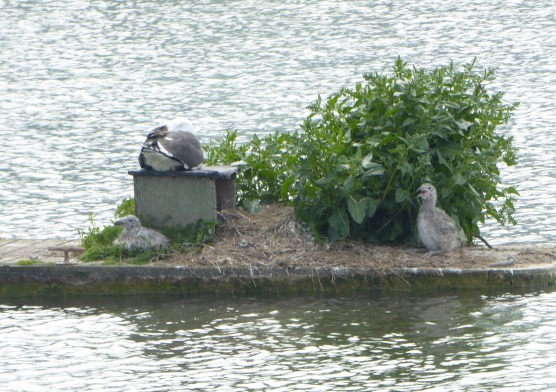
For
earlier entries go to . . . May
17-31